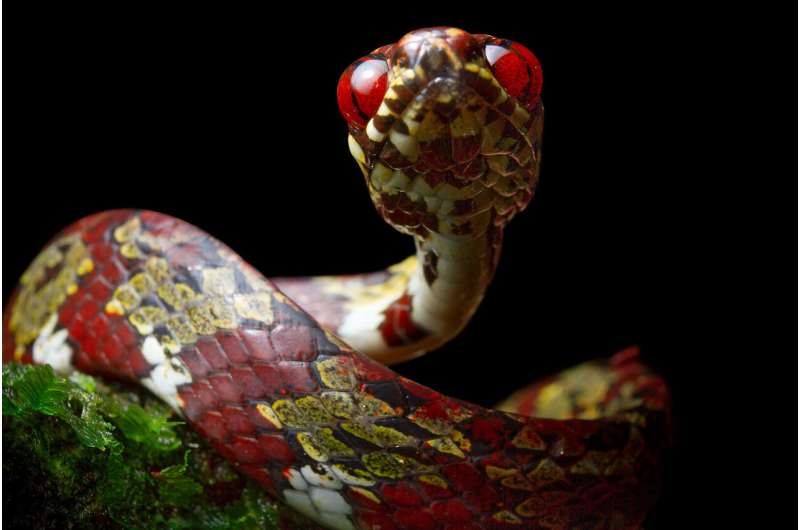This article has been reviewed according to Science X's editorial process and policies. Editors have highlighted the following attributes while ensuring the content's credibility:
fact-checked
peer-reviewed publication
trusted source
proofread
Newly-named species of tree-dwelling snakes threatened by mining

Five new tree-dwelling snake species were discovered in the jungles of Ecuador, Colombia, and Panama. Conservationists Leonardo DiCaprio, Brian Sheth, Re:wild, and Nature and Culture International chose the names for three of them in honor of loved ones while raising awareness about the issue of rainforest destruction at the hands of open-pit mining operations. The research was conducted by Ecuadorian biologist Alejandro Arteaga and Panamanian biologist Abel Batista.
The mountainous areas of the upper-Amazon rainforest and the Chocó-Darién jungles are world-renowned for the wealth of new species continually discovered in this region. However, it is becoming increasingly clear that they also house some of the largest gold and copper deposits in the world. During the COVID-19 pandemic, the proliferation of illegal open-pit gold and copper mining operations in the jungles of Ecuador, Colombia, and Panama reached a critical level and is decimating tree-dwelling snake populations.
Neotropical snail-eating snakes (genera Sibon and Dipsas) have a unique lifestyle that makes them particularly prone to the effects of gold and copper mining. First, they are arboreal, so they cannot survive in areas devoid of vegetation, such as in open-pit mines. Second, they feed exclusively on slugs and snails, a soft-bodied type of prey that occurs mostly along streams and rivers and is presumably declining because of the pollution of water bodies.
"When I first explored the rainforests of Nangaritza River in 2014, I remember thinking the place was an undiscovered and unspoiled paradise," says Alejandro Arteaga, author of the research study on these snakes, which was published in the journal ZooKeys. "In fact, the place is called Nuevo Paraíso in Spanish, but it is a paradise no more. Hundreds of illegal gold miners using backhoe loaders have now taken possession of the river margins, which are now destroyed and turned into rubble."
The presence of a conservation area may not be enough to keep the snail-eating snakes safe. In southeastern Ecuador, illegal miners are closing in on Maycu Reserve, ignoring landowner rights and even making violent threats to anyone opposed to the extraction of gold. Even rangers and their families are tempted to quit their jobs to work in illegal mining, as it is much more lucrative.

A local park ranger reports that by extracting gold from the Nangaritza River, local people can earn what would otherwise be a year's salary in just a few weeks. "Sure, it is illegal and out of control, but the authorities are too afraid to intervene," says the park ranger. "Miners are just too violent and unpredictable."
In Panama, large-scale copper mining is affecting the habitat of two of the new species: Sibon irmelindicaprioae and S. canopy. Unlike the illegal gold miners in Ecuador and Colombia, the extraction in this case is legal and at the hands of a single corporation: Minera Panamá S.A., a subsidiary of the Canadian-based mining and metals company First Quantum Minerals Ltd. Although the forest destruction at the Panamanian mines is larger in extent and can easily be seen from space, its borders are clearly defined and the company is under the purview of local environmental authorities.

"Both legal and illegal open-pit mines are uninhabitable for the snail-eating snakes," says Arteaga, "but the legal mines may be the lesser of two evils. At the very least they respect the limit of nearby protected areas, answer to a higher authority, and are presumably unlikely to enact violence on park rangers, researchers, and conservationists."
Sibon canopy, one of the newly described species, appears to have fairly stable populations inside protected areas of Panama, although elsewhere nearly 40% of its habitat has been destroyed. At Parque Nacional Omar Torrijos, where it is found, there has been a reduction in the number of park rangers (already very few for such a large protected area). This makes it easier for loggers and poachers to reach previously unspoiled habitats that are essential for the survival of the snakes.

Lack of employment and the high price of gold aggravate the situation. No legal activity can compete against the "gold bonanza." More and more often, farmers, park rangers, and indigenous people are turning to illegal activities to provide for their families, particularly during crisis situations like the COVID-19 pandemic, when NGO funding was at its lowest.
"These new species of snake are just the tip of the iceberg in terms of new species discoveries in this region, but if illegal mining continues at this rate, there may not be an opportunity to make any future discoveries," concludes Alejandro Arteaga.

Fortunately, three NGOs in Ecuador and Panama (Khamai, Nature and Culture International, and Adopta Bosque) have already made it their mission to save the snake's habitat from the emerging gold mining frenzy. Supporting these organizations is vital, because their quest for immediate land protection is the only way to save the snakes from extinction.
More information: Alejandro Arteaga et al, A consolidated phylogeny of snail-eating snakes (Serpentes, Dipsadini), with the description of five new species from Colombia, Ecuador, and Panama, ZooKeys (2023). DOI: 10.3897/zookeys.1143.93601
Journal information: ZooKeys
Provided by Pensoft Publishers

















